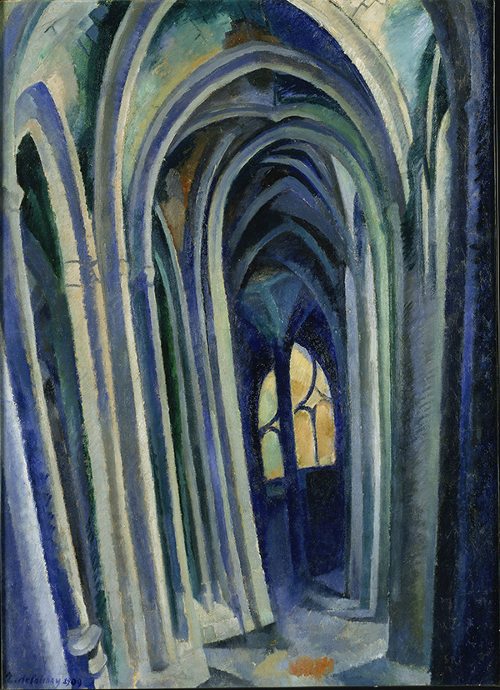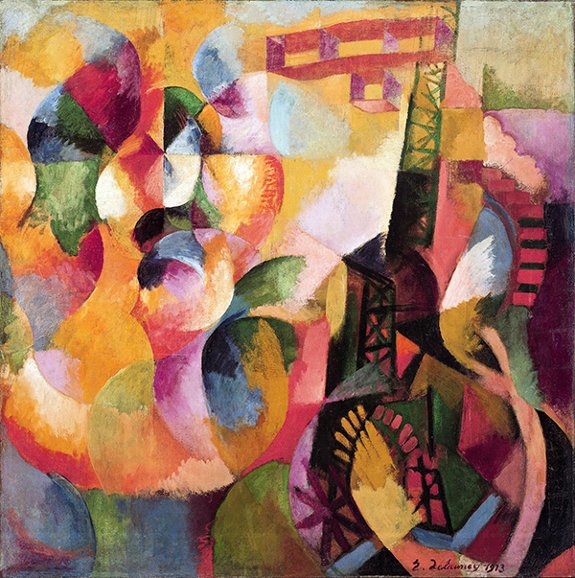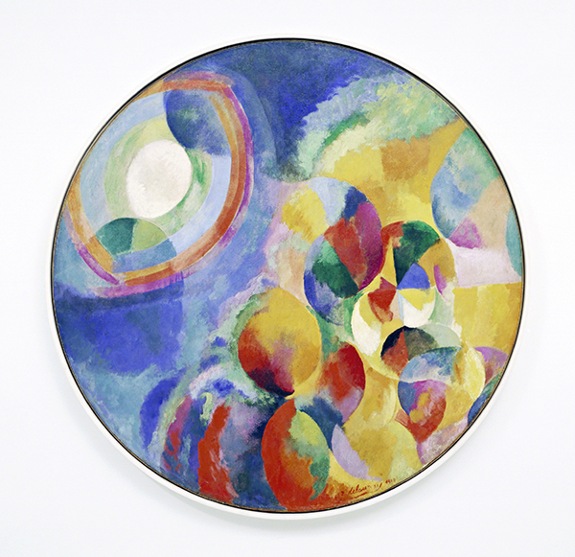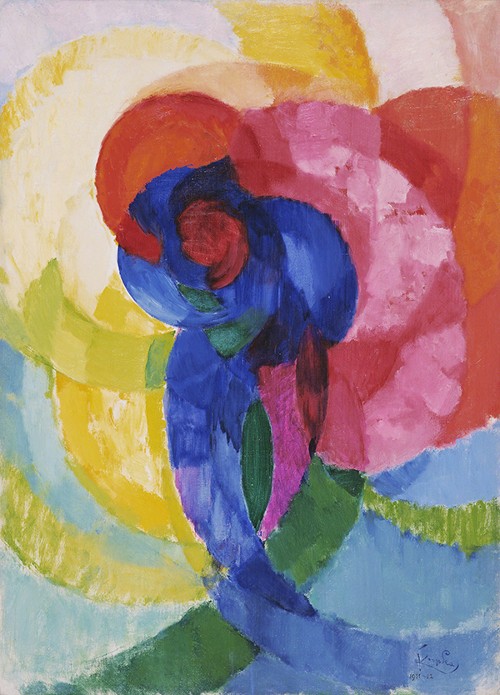Election Year Antidote: Robert Delaunay
There is seriously no better distraction from a nerve-wracking election year than to look at beautiful art. By now you know my idea of “beautiful” is FULL OF VIBRANT COLOR. Robert Delaunay is one artist whose paintings truly fit that bill!
 |
| Robert Delaunay (1885–1941, France), Saint-Séverin, 1909. Oil on canvas, 38" x 27 ¾" (96.5 x 70.5 cm). Image © 2024 Philadelphia Museum of Art. (PMA-9162) |
This magnificent painting had a great impact on me when I first saw it as a young painter in high school. Delaunay's first series from 1909 and 1910 charted the modulations of light streaming through stained-glass windows and the resulting perceptual distortion of the architecture in seven paintings. This painting from the series shows the view into the ambulatory—an aisle around the semi-circular apse at the eastern end of the church—in the Church of Saint-Séverin. Located in Paris, Saint-Séverin is a Gothic church begun in 1230 and rebuilt or expanded in the 1400s, 1500s, and 1600s.
There is a subdued palette in Delaunay’s Saint-Séverin paintings that is reminiscent of the late works of Paul Cézanne (1839–1906). The swatches of color that enliven the church's surfaces is also relatable to Cézanne's "constructive" technique that inspired Cubism. Saint-Séverin also reveals Delaunay's fascination with windows, which linked his work to that of Symbolist artists and the use of glass panes as metaphors for transitioning from internal to external states.
 |
| Robert Delaunay, Sun, Tower, Airplane, 1913. Oil on canvas, 52" x 51 ⅝" (132.1 x 131.1 cm). Image © 2024 Buffalo AKG Art Museum, Buffalo, New York. (AK-229) |
Delaunay explored the developments of Cubist fragmentation more explicitly in his Eiffel Tower series. He had great enthusiasm for the rapid change and technological developments of contemporary life in the early years of the 1900s. Sun, Tower, Airplane highlights three symbols of late 1800s and early 1900s modernity: the Eiffel Tower, a biplane, and a Ferris wheel. Delaunay conveys his excitement about such marvels through energetic lines, shapes, and the warm, bright colors that radiate from a kaleidoscopic sun.
Early on in his career, Delaunay painted in a Neo-Impressionist manner. He was briefly associated with Cubism from 1909 to 1911. By 1912, however, Delaunay became increasingly preoccupied with the dynamics of color relationships. At this time, he made his first “disc” painting, deploying the motif as a symbol for the sun and, ultimately, the universe.
 |
| Robert Delaunay, Simultaneous Contrasts – Sun and Moon, 1913. Oil on canvas, 53" x 53" (134.5 x 134.5 cm). Image © 2024 The Museum of Modern Art, New York. (MOMA-P0238) |
In his Eiffel Tower paintings of 1909 to 1910, Delaunay explored not only the fragmentation of forms representing the shifting vantage points of Cubism, but also the suggestion of rapid motion in the visual sense of vibration of colors. In Simultaneous Contrasts – Sun and Moon, that movement is the rhythm of the cosmos as the painting's circular frame is a symbol for the universe. This may reflect the ideas of the Futurists in the manifesto they published in 1910.
Delaunay called his method for capturing light through color "simultaneity.” He believed that the breaking up of form by light created color planes. By 1913, he had abandoned any pretense of subject in arrangements of vibrantly colored circles and shapes such as Simultaneous Contrasts - Sun and Moon. These totally abstract works are often termed his Disk paintings. During this period, he continued to paint representational works alongside his abstractions.
Simultaneous Contrasts – Sun and Moon should totally remind you of the Disk paintings by post-Cubist artist František Kupka (1871–1957), which Kupka executed in Paris around the same time.
 |
| František Kupka (1871–1957, France, born Czechoslovakia), Red and Blue Disks, dated on painting 1911–1912. Oil on canvas, 39 ⅜" x 28 ¾" (100 x 73 cm). The Museum of Modern Art, New York, purchase. © 2024 Artists Rights Society (ARS), New York. (MOMA-P2125kuars) |
The collaboration between Pablo Picasso (1881–1973) and Georges Braque (1882–1963) in France in 1908 led to the development of Cubism. Cubism was an entirely new perception of how artists could interpret three-dimensional space in two dimensions. It totally dispensed with centuries of reliance on one-point linear perspective. It also paved the way for total abstraction.
Cubism reduced compositions to interconnecting geometric shapes and planes, introducing the element of time and multiple viewpoints to a work of art. While Picasso and Braque moved on to other experiments, often incorporating elements of Cubism, many artists explored the medium for long periods of their careers. Cubism inevitably, and probably unavoidably, was combined by some artists with the modern fascination with machinery and the industrialization of Western Europe. The Cubist search for new forms opened the door to many artists to explore abstraction in various versions of the style.
During his childhood, Delaunay spent time painting watercolors in his school classes. As a young man, he was apprenticed in a theater design studio in Belleville. At 18, he met the naïve painter Henri Rousseau (1844–1910) while in Brittany, and saw the works of the Post-Impressionist Pont-Aven Group. In Paris, he first became acquainted with future Cubist Jean Metzinger (1883–1956).
Gradually, Delaunay came to embrace all of the modernist experiment in Paris, alternating between total abstraction and a geometric abstraction that was based in Cubism. However, Delaunay's primary concern was expressing physical forms purely in terms of color. He settled on a Cubist-derived style in which color was the subject matter. The poet Guillaume Apollinaire (1880–1918) termed Delaunay's style Orphism, based on the ancient Greek lyre-playing Orpheus, likening Delaunay's fervor for painting to that of playing music by Orpheus.
Correlations to Davis programs: Explorations in Art 2E Grade 2: 1.5; Explorations in Art 2E Grade 4: 3.9; Explorations in Art 2E Grade 5: 6.4; Explorations in Art 2E Grade 6: 1.7; Experience Art: 1.7, 5.1; A Global Pursuit 2E: 8.4; The Visual Experience 4.E: 5.2


Comments